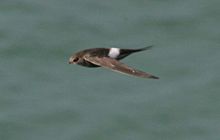- Pacific Swift
-
This article is about the bird. For the Tall Ship owned by S.A.L.T.S., see Pacific Swift (ship).
Pacific Swift 
Conservation status Scientific classification Kingdom: Animalia Phylum: Chordata Class: Aves Order: Apodiformes Family: Apodidae Genus: Apus Species: A. pacificus Binomial name Apus pacificus
(Latham, 1802)The Pacific Swift (Apus pacificus), is a small bird, superficially similar to a House Martin. It is, however, completely unrelated to those passerine species, since swifts are in the order Apodiformes. The resemblances between the groups are due to convergent evolution reflecting similar life styles.
These birds have very short legs which they use only for clinging to vertical surfaces. The scientific name comes from the Greek απους, apous, meaning "without feet". They never settle voluntarily on the ground. Pacific Swifts spend most of their lives in the air, living on the insects they catch in their beaks.
Pacific Swifts breeds from central Siberia eastwards through Asia. This species is migratory, wintering south to Australia. It is a rare vagrant in western Europe, but has been recorded as far west as Norway and Great Britain. A 2011 study suggests that the populations can be treated as four distinct species. In this treatment Apus pacificus in the more restricted sense refers to the population that breeds from Siberia to Japan and winters in Southeast Asia east to Tasmania. The breeding population of the Tibetan Plateau is longer tailed and a narrow white rump has been called Salim Ali's Swift A. salimali. The breeders along the Himalayas of Nepal and Bhutan are treated as Blyth's Swift (A. leuconyx). Cook's Swift (A. cooki) which breeds in limestone caves of northern Southeast Asia has a green iridescence, a shallow tail fork and is a short distance migrant.[2]
These swifts build their nests on cliffs, laying 2-3 eggs. A swift will return to the same site year after year, rebuilding its nest when necessary.
Pacific Swifts are similar in size to Common Swift, and they are black except for a white rump. They can be distinguished from a partially leucistic Common Swift by the deeper tail fork, longer wings, bigger head and larger white throat patch.
References
- ^ BirdLife International (2004). Apus pacificus. 2006. IUCN Red List of Threatened Species. IUCN 2006. www.iucnredlist.org. Retrieved on 11 May 2006. Database entry includes justification for why this species is of least concern
- ^ Leader, P J. (2011). "Taxonomy of the Pacific Swift Apus pacificus Latham, 1802, complex". Bulletin of the British Ornithologists' Club 131: 81–93.
Categories:- IUCN Red List least concern species
- Apus
- Birds of Japan
- Birds of South Australia
- Birds of Western Australia
Wikimedia Foundation. 2010.

